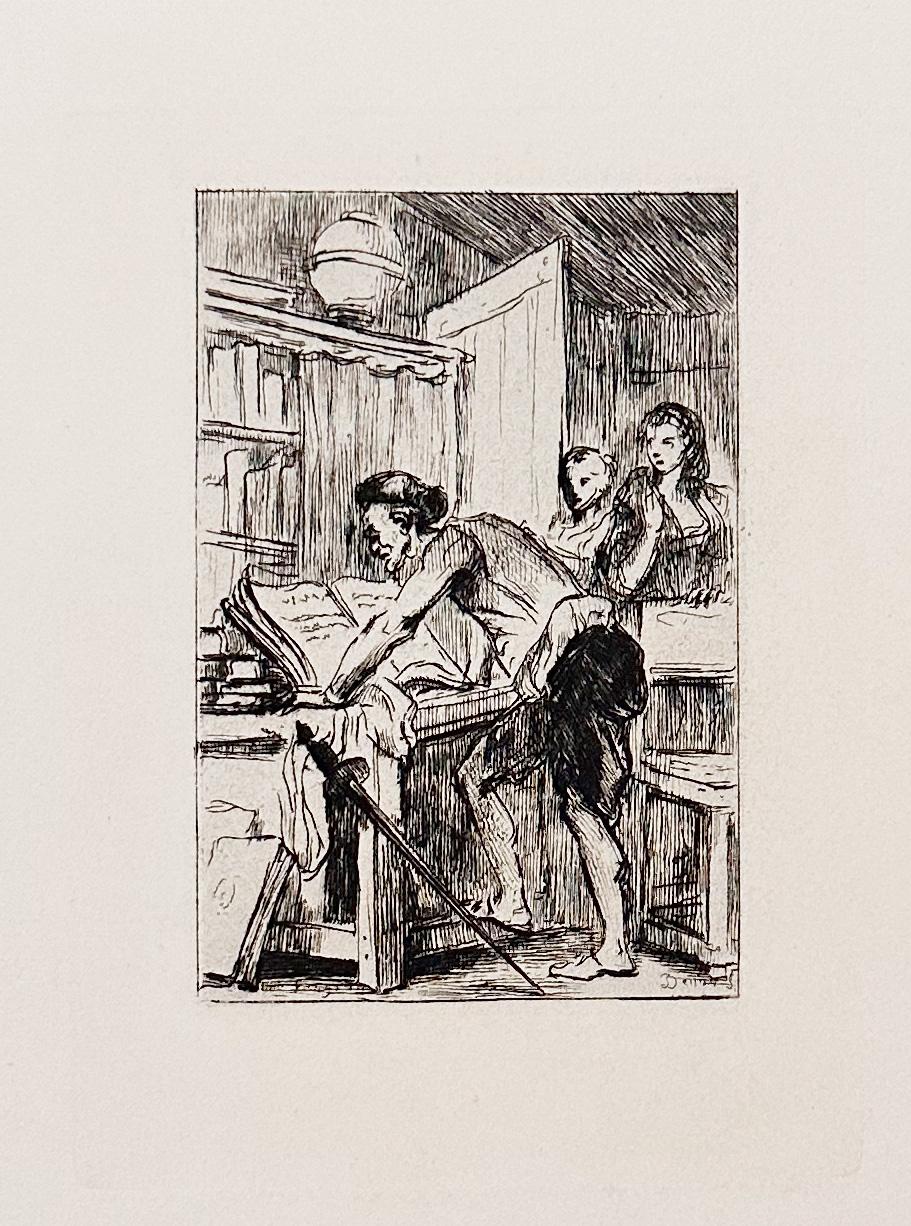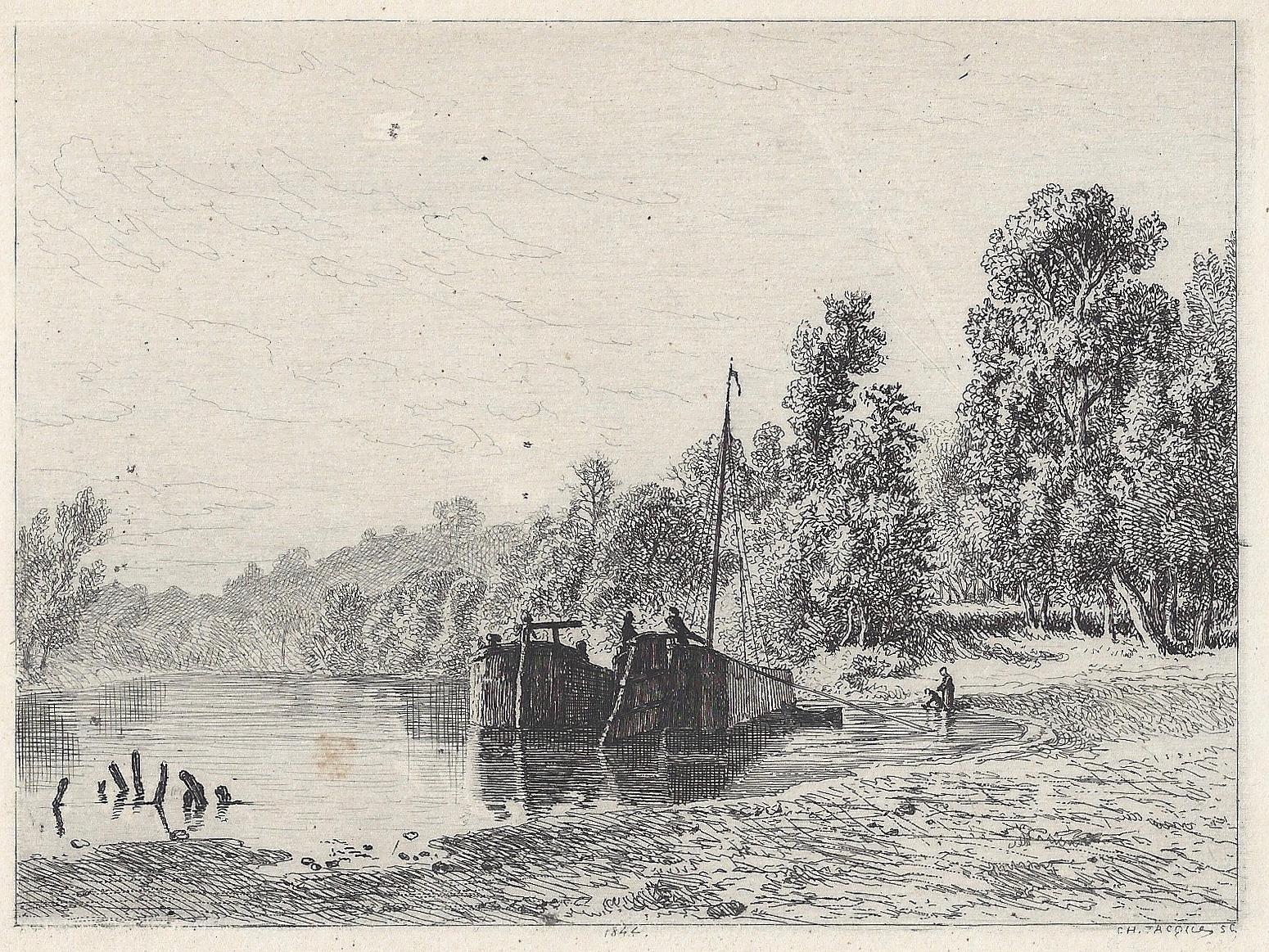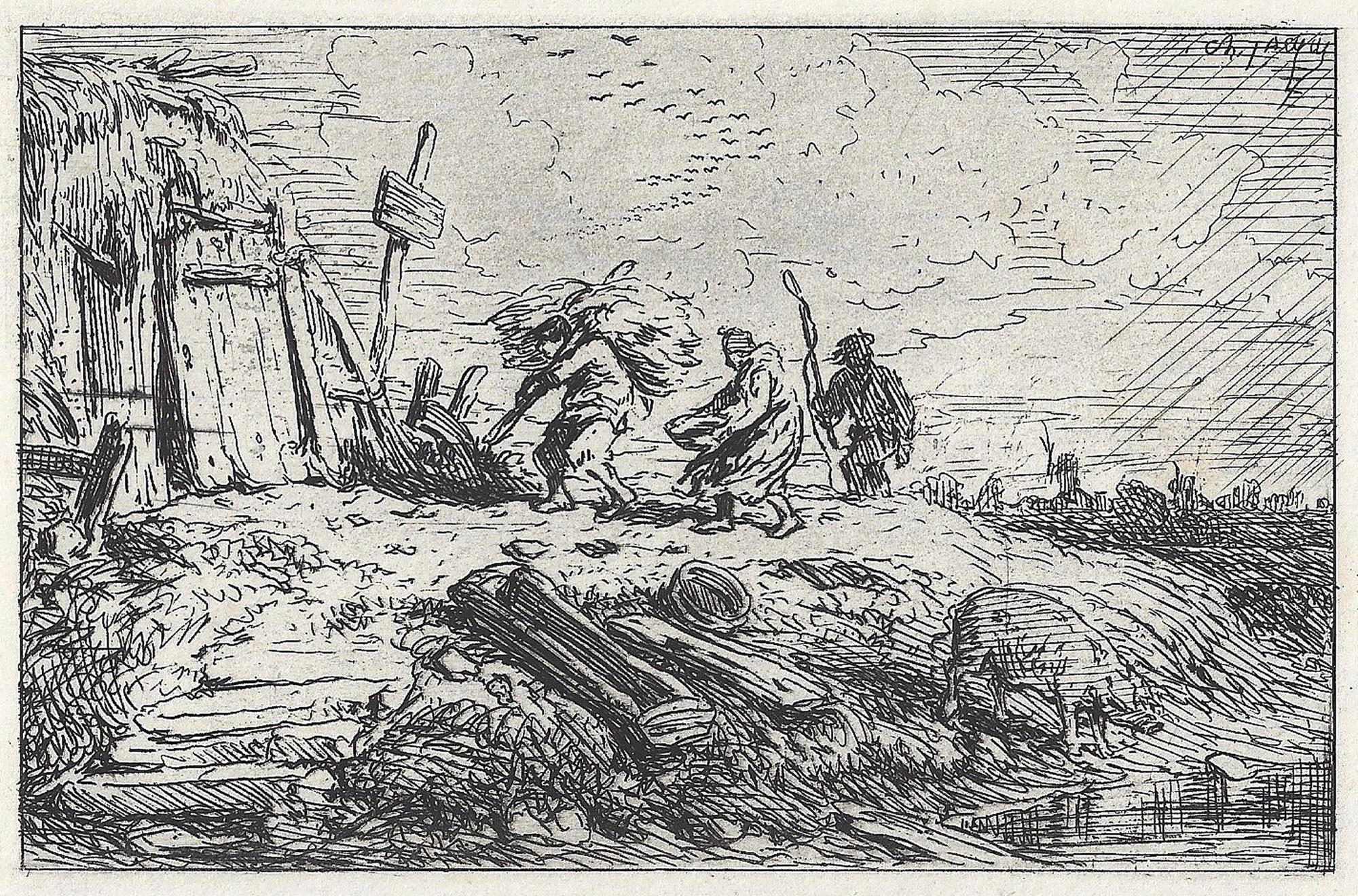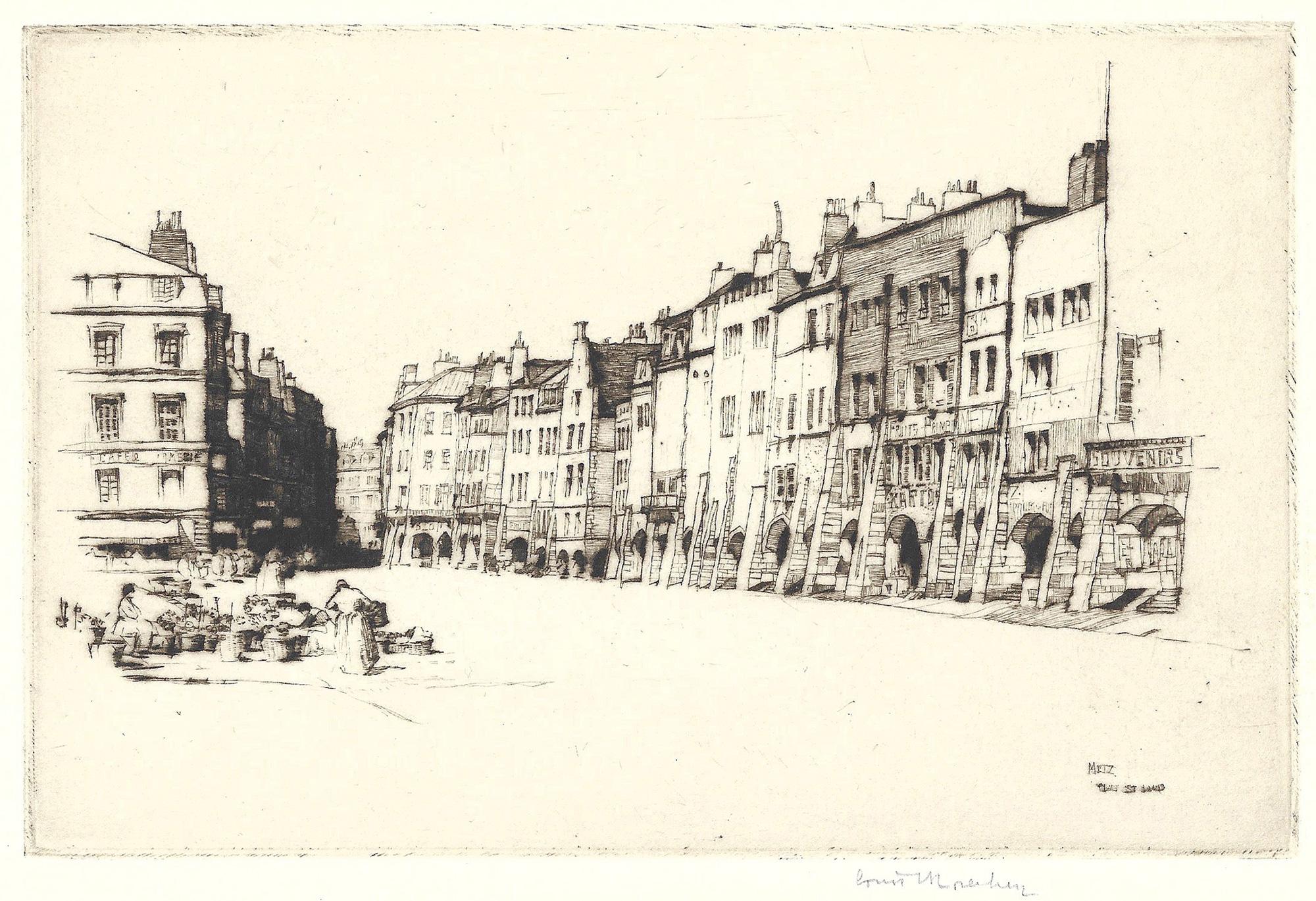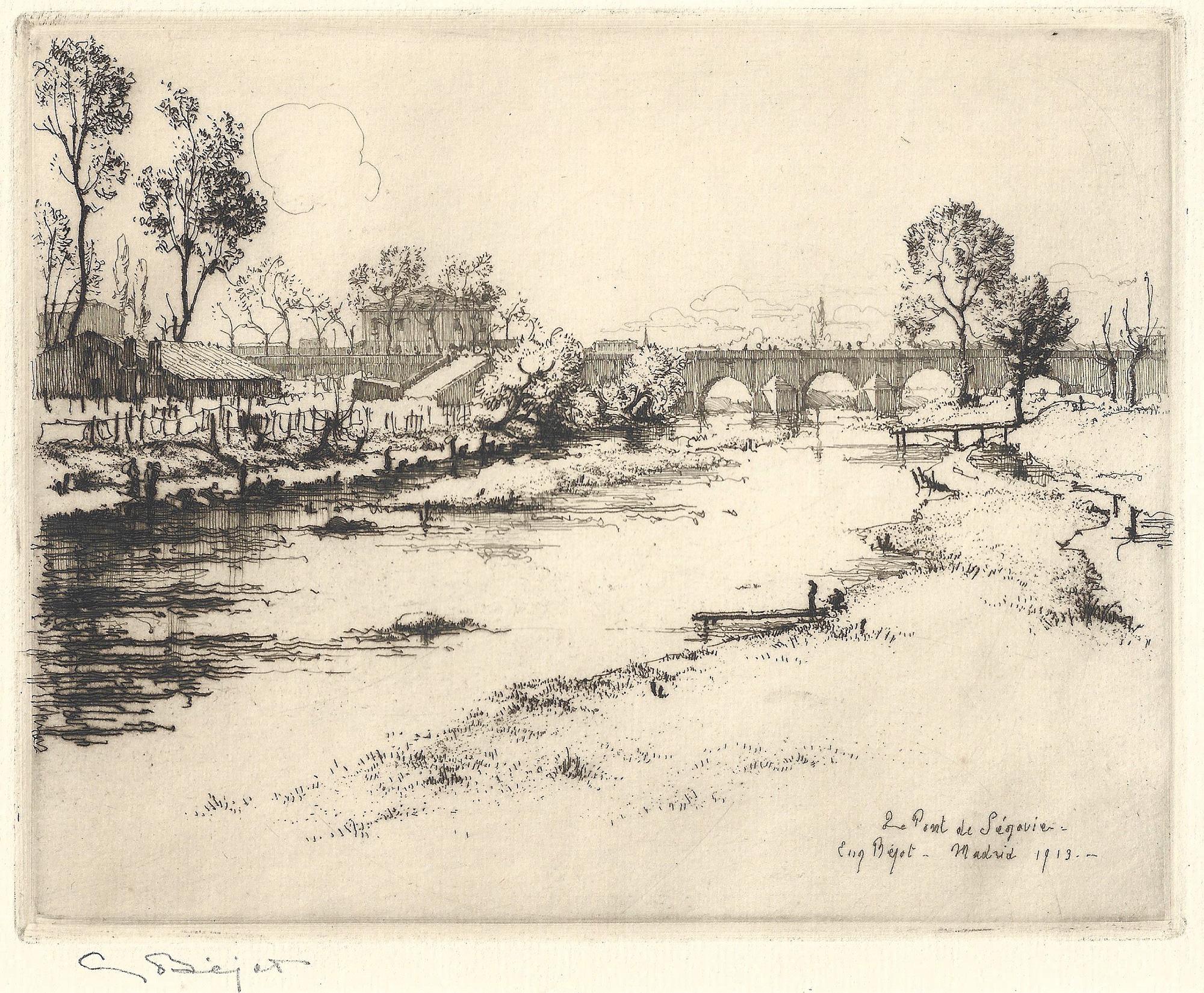Items Similar to Bois de la Haye
Want more images or videos?
Request additional images or videos from the seller
1 of 2
Bois de la Haye1867
1867
About the Item
Etching and lithograph on cream wove paper, 6 x 8 3/4 inches (151 x 220 mm), full margins. With some scattered light spots of yellowing in the margins on the recto, outside of image area, and more advanced yellowing in five to seven places on the verso, also in the area of the left margin. Adhesive residue and skinning along the top extreme sheet edge, otherwise in good condition.
After a painting of the same name executed 1864–65 by Paul Huet. From the first state, before the edition printed by Alfred Salmon and published with text in “Gazette des Beaux-Arts” (1 October 1867), Paris.
- Creation Year:1867
- Dimensions:Height: 6 in (15.24 cm)Width: 8.75 in (22.23 cm)
- Medium:
- Movement & Style:
- After:Paul Huet (1803-1869, French)
- Period:
- Condition:
- Gallery Location:Middletown, NY
- Reference Number:
About the Seller
5.0
Vetted Seller
These experienced sellers undergo a comprehensive evaluation by our team of in-house experts.
Established in 2004
1stDibs seller since 2022
30 sales on 1stDibs
Typical response time: 11 hours
- ShippingRetrieving quote...Ships From: Middletown, NY
- Return PolicyA return for this item may be initiated within 30 days of delivery.
More From This SellerView All
- Don Quixote ReadingBy Jean-Honoré FragonardLocated in Middletown, NYEtching on a large sheet of light cream wove paper, Baron Dominique Vivant Denon (after Jean-Honoré Fragonard); Paris: c 1900; 4 3/4 x 3 1/2 inches (120 x 90 mm), full margins. In go...Category
Early 20th Century French School Figurative Prints
MaterialsEtching, Handmade Paper
- Bords d'une rivière avec deux bateaux (River banks with two boats)By Charles-Emile JacqueLocated in Middletown, NYEtching on chine collé mounted to white wove paper, 3 11/16 x 5 (92 x 125 mm), full margins. In good condition with minor mat tone. Printed by Delâtre, Paris. [Guiffrey 34]Category
Mid-19th Century French School Landscape Prints
MaterialsHandmade Paper, Etching
- Une bourrasqueBy Charles-Emile JacqueLocated in Middletown, NYEtching on chine collé mounted to white wove paper, 3 x 4 5/8 inches (75 x 112 mm), full margins. Scattered light areas of adhesive residue with associated discoloration along the to...Category
Mid-19th Century French School Landscape Prints
MaterialsHandmade Paper, Etching
- Place St. Louis, MetzBy Louis Conrad RosenbergLocated in Middletown, NYDrypoint on cream wove paper, 4 1/2 x 6 7/8 inches (114 x 174 mm), full margins. Signed in pencil, lower right margin. In very good condition with no visible defects; inking is exce...Category
Mid-20th Century French School Landscape Prints
MaterialsHandmade Paper, Etching
- Don QuixoteBy Jean-Honoré FragonardLocated in Middletown, NYEtching on a large sheet of light cream wove paper, Baron Dominique Vivant Denon (after Jean-Honoré Fragonard); Paris: c 1900; 4 3/4 x 3 1/2 inches (120 x 90 mm), full margins. In go...Category
Early 20th Century French School Figurative Prints
MaterialsHandmade Paper, Etching
- Le Pont de SegovieBy Eugene BejotLocated in Middletown, NYEtching on cream wove paper, 5 1/2 x 7 inches (138 x 176 mm), full margins. Signed in pencil in the lower margin. With minor mat tone, and two pin-point spots of light discoloration ...Category
Early 20th Century French School Landscape Prints
MaterialsHandmade Paper, Etching
You May Also Like
- Toulouse Lautrec Original Lithograph Famous Political 1800s Collection SignedBy Henri de Toulouse-LautrecLocated in Milwaukee, WI"Lautrec Book: From Au Pied du Sinai written by Georges Clemenceau" lithographs created by the legendary Henri de Toulouse-Lautrec. This book, Au Pied...Category
1890s Post-Impressionist Figurative Prints
MaterialsLithograph, Mulberry Paper
- "Enshoku Sanju-roku Kasen" (Thirty-six Enchanting Flowers) Woodblock on paperBy Toyohara KunichikaLocated in Soquel, CA"Enshoku Sanju-roku Kasen" (Thirty-six Enchanting Flowers) Woodblock on paper Elegant woodblock print by Toyohara Kunuchika (Japanese, 1835-1900). Three women are in talking with each other inside, while a man waits outside holding a bag of some kind. The colors in this piece are rich and saturated, primarily blues, greens, and purple. Mat size: 16"H x 20"W Paper size: 14.75"H x 9.88"W Born in 1835, Toyohara Kunichika grew up in the Kyobashi district of Edo in the midst of merchants and artisans. In 1848, at age 13, he was accepted as an apprentice into the studio of Utagawa Kunisada I...Category
1880s Edo Figurative Prints
MaterialsInk, Rice Paper, Woodcut
- Kiyomizu Temple, Scenes of Famous Places along Tôkaidô Road - Woodblock on PaperBy Utagawa Hiroshige IILocated in Soquel, CAKiyomizu Temple, Scenes of Famous Places along Tôkaidô Road - Woodblock on Paper Full Title: Kyoto: Kiyomizu Temple (Kyô Kiyomizudera), from the series Scenes of Famous Places along...Category
1860s Edo Landscape Prints
MaterialsInk, Rice Paper, Woodcut
- "Various Himochi" Wagashi Festival Japanese Woodblock Print by Utagawa ToyokuniLocated in Soquel, CA"Various Himochi" Wagashi Festival Japanese Woodblock Print by Utagawa Toyokuni Rare oversized early 19th century 5-tiered woodblock by Utagawa Ichiyosai Toyokuni, (Japan, 1769-1825), a Japanese lord and wife oversee a sekku festival of food, music, and dolls or toys. '"oshi" is the first day of “Mi (Snake)” in the third month of the lunar calendar. This day, known in modern Japan as the Girls' Festival, originated in China as a form of purification ceremony in which water and drinking peach blossom wine were used to drive away evil. Many kinds of hishi-mochi appear in this picture of hina ningyo (dolls associated with Hinamatsuri, or the Girl’s Day) from Omochae. The custom of eating special dishes at events throughout the year and at milestones in people's lives has existed since ancient times. This paragraph specifically focuses on the annual event called sekku, and life events that involve eating sweets. Joshi is the first day of “Mi (Snake)” in the third month of the lunar calendar. This day, known in modern Japan as the Girls' Festival, originated in China as a form of purification ceremony in which water and drinking peach blossom wine were used to drive away evil. According to the Keiso saijiki, in ancient China, on the third day of the third lunar month, people ate “ryuzetsuhan,” which is the juice of gogyo (Jersey cudweed) mixed with rice flour and nectar. In Japan, there is a record in the Heian period history book Nihon Montoku tenno jitsuroku [839-5] that it was an annual event to make kusamochi using gogyo on the third day of the third month of the lunar calendar, which may have been influenced by Chinese customs. The tradition of eating kusamochi on the third day of the third month of the lunar calendar continued after that. By the Edo period, however, hishimochi had come to be used as a sweet to serve on the third day of the third month. A picture of a hishimochi is included in the Morisada manko , which we mentioned in Part 1. According to it, hishimochi in the Edo period were often three layers of green-white-green instead of the now common red-white-green. However, it is possible to see from our collection that not all hishimochi were made in this way. Omochae published in 1857, is a good example. Omochae is a type of ukiyoe print...Category
1820s Edo Figurative Prints
MaterialsInk, Rice Paper, Woodcut
- "First Horse Day, 1896" - Chiyoda Palace - Japanese Woodblock by Chikanobu YoshuBy Toyohara ChikanobuLocated in Soquel, CA"First Horse Day, 1896" - Chiyoda Palace - Japanese Woodblock by Chikanobu Yoshu Colorful and expressive court scne by Toyohara Chikanobu,"Yoshu" (Japanese, 1838-1912). This is the r...Category
1890s Edo Figurative Prints
MaterialsRice Paper, Ink, Woodcut
- Festival Procession Of A Daimyo - Original Woodblock PrintLocated in Soquel, CAProcession Of A Daimyo - Original Woodblock Print Original woodblock print depicting the procession of a Daimyo. Ten Japanese soldiers are seen as they aid in transporting the Daimy...Category
Late 18th Century Edo Figurative Prints
MaterialsInk, Wood Panel, Rice Paper
